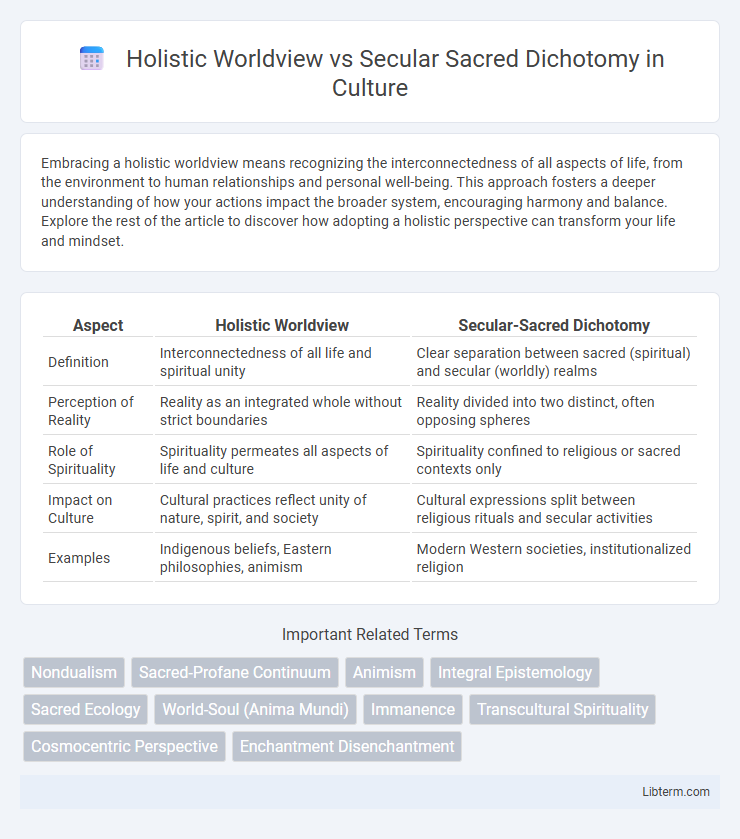Embracing a holistic worldview means recognizing the interconnectedness of all aspects of life, from the environment to human relationships and personal well-being. This approach fosters a deeper understanding of how your actions impact the broader system, encouraging harmony and balance. Explore the rest of the article to discover how adopting a holistic perspective can transform your life and mindset.
Table of Comparison
| Aspect | Holistic Worldview | Secular-Sacred Dichotomy |
|---|---|---|
| Definition | Interconnectedness of all life and spiritual unity | Clear separation between sacred (spiritual) and secular (worldly) realms |
| Perception of Reality | Reality as an integrated whole without strict boundaries | Reality divided into two distinct, often opposing spheres |
| Role of Spirituality | Spirituality permeates all aspects of life and culture | Spirituality confined to religious or sacred contexts only |
| Impact on Culture | Cultural practices reflect unity of nature, spirit, and society | Cultural expressions split between religious rituals and secular activities |
| Examples | Indigenous beliefs, Eastern philosophies, animism | Modern Western societies, institutionalized religion |
Understanding the Holistic Worldview
The holistic worldview integrates interconnectedness among all aspects of existence, emphasizing unity rather than division between the spiritual and material realms. This perspective allows for a seamless experience of life, where sacredness is inherent within everyday reality and human relationships with nature. Embracing a holistic worldview fosters ecological awareness, spiritual depth, and a profound sense of meaning beyond secular-sacred dichotomies.
Defining the Secular-Sacred Dichotomy
The secular-sacred dichotomy defines a conceptual division where secular refers to worldly, non-religious aspects of life, while sacred pertains to elements imbued with religious or spiritual significance. This binary framework separates institutionalized religion and spiritual experiences from everyday, political, or scientific domains. Understanding this dichotomy is essential for analyzing how societies compartmentalize belief systems and cultural practices.
Historical Roots of Both Perspectives
The holistic worldview traces back to ancient indigenous and Eastern philosophies emphasizing interconnectedness and spiritual unity, contrasting with the secular sacred dichotomy rooted in Enlightenment thought which separates the material and spiritual realms. Historically, the holistic perspective integrates nature, spirituality, and human experience as an inseparable whole, while the secular sacred divide emerged from Western religious transformations and the rise of scientific rationalism in the 17th and 18th centuries. These divergent origins shape contemporary debates on the integration of spirituality and secular knowledge in culture and society.
Core Principles of Holistic Thinking
Holistic thinking emphasizes interconnectedness, recognizing that all elements within a system influence one another, fostering a comprehensive understanding beyond isolated facts. It integrates spiritual, ecological, and human dimensions, promoting balance and harmony between mind, body, and environment. This approach contrasts with the secular sacred dichotomy by dissolving rigid separations and viewing reality as an inseparable web of relationships rather than distinct sacred and secular realms.
How the Secular-Sacred Divide Shapes Modern Life
The secular-sacred divide profoundly influences modern life by segmenting social experiences into rational, scientific domains and spiritual, religious realms, shaping cultural norms and public policies. This dichotomy often dictates the separation of church and state, affecting education systems, legal frameworks, and moral debates on issues like bioethics and human rights. The ongoing negotiation between secularism and sacred beliefs drives societal conflicts and collaborations, influencing how individuals construct identity and community in contemporary settings.
Impacts on Personal and Collective Wellbeing
Holistic worldview integrates spiritual, emotional, and physical dimensions, fostering a sense of interconnectedness that enhances personal resilience and collective harmony. In contrast, the secular sacred dichotomy often separates spiritual experiences from daily life, potentially leading to fragmented wellbeing and reduced communal empathy. Embracing holistic perspectives promotes mental health, social cohesion, and sustainable living practices that benefit both individuals and societies.
Religious and Spiritual Implications
Holistic worldview embraces the interconnectedness of all life, integrating spiritual, religious, and ecological dimensions into a unified understanding of existence. In contrast, the secular sacred dichotomy separates the sacred from everyday life, often relegating spirituality to private or institutional domains while emphasizing rational, scientific perspectives. This division impacts religious practices by limiting spiritual experiences within specific rituals, whereas a holistic approach encourages spirituality as an ongoing, integrated aspect of personal and communal life.
Societal Consequences of Worldview Differences
Holistic worldviews integrate spiritual and secular dimensions, fostering community cohesion, environmental stewardship, and a sense of interconnectedness that influences societal behavior and policies. Secular sacred dichotomy separates religious values from public life, often leading to secular governance structures that prioritize empirical evidence and individual rights but may reduce communal bonds and collective moral frameworks. These divergent worldviews shape societal priorities, impacting education systems, legal frameworks, and collective responses to social and ecological challenges.
Bridging the Gap: Integrative Approaches
Integrative approaches bridge the gap between holistic worldview and secular sacred dichotomy by emphasizing interconnectedness and unity beyond traditional boundaries. These methods incorporate spiritual insights into secular contexts, fostering dialogue and mutual understanding across diverse belief systems. Embracing integrative frameworks facilitates harmony between scientific inquiry and spiritual experience, enriching both perspectives.
Charting a Path Forward for Unified Living
The holistic worldview integrates spiritual and secular perspectives, recognizing interconnectedness across all aspects of life and fostering unity rather than division. This approach challenges the secular sacred dichotomy by blending ethical values with practical living, promoting harmony between inner beliefs and external actions. Charting a path forward for unified living involves embracing this synthesis to create inclusive communities grounded in shared meaning and collaborative progress.
Holistic Worldview Infographic

 libterm.com
libterm.com